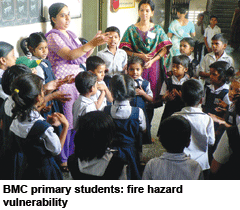Five months after a devastating fire in Mantralaya — headquarters of the Maharashtra state govern-ment — which destroyed the offices of the chief minister and the deputy chief minister on June 21, and took a toll of two dead and 16 injured, a survey made public on October 29, reveals that an estimated 1.64 million school-going children in Mumbai are highly vulnerable to fire hazard.
According to the survey conducted by the city’s Parents Teachers Association United Forum (PTAUF), a non-profit organisation, the great majority of schools in Mumbai (pop. 20.5 million) are violating fire safety norms with impunity, placing the lives of a million children at risk. The survey, which covered 300 city schools — 100 municipal, 100 private aided and 100 unaided — reveals that only a handful of private schools and few civic schools have taken the precaution of installing fire extinguishers in science laboratories where chances of fire outbreak are maximum. Most schools surveyed didn’t have emergency exits; rarely conducted fire safety audits and couldn’t produce fire insurance proof.
 Of the 300 schools randomly surveyed, only 7 percent aided and 10 percent of unaided schools have installed fire alarms, while none of the BMC (Brihanmumbai Municipal Corp-oration) schools had alarms or sand buckets. Inevitably, none of the schools covered had fire exits or had conducted fire-fighting training for students and staff.
Of the 300 schools randomly surveyed, only 7 percent aided and 10 percent of unaided schools have installed fire alarms, while none of the BMC (Brihanmumbai Municipal Corp-oration) schools had alarms or sand buckets. Inevitably, none of the schools covered had fire exits or had conducted fire-fighting training for students and staff.
According to Arundhati Chavan, PTAUF president, child safety is a non-issue in all schools in Mumbai. “School managements stop at installing a solitary fire extinguisher. Other issues such as untrained teachers, narrow staircases and cramped classrooms don’t seem to bother them. Instead of being proactive in the matter of child safety, the state government is reactionary. Schools in Mumbai were last inspected by the authorities two years ago in 2010. PTAUF will soon be submitting a full report to the education ministry and the fire brigade demanding enforcement of fire and other safety norms in all schools,” says Chavan.
Following the horrific death by fire of 83 children of the Lord Krishna Middle School in Kumbakonam, Tamil Nadu, in July 2004, a writ petition (civil) No.483 (Avinash Mehrotra vs. Union of India & others) was filed in the Supreme Court. On April 13, 2009, the court ordered all school managements countrywide to strictly comply with safety norms prescribed by the National Building Code of India (NBCI), 2005 and asked states and Union territories to de-recognise non-compliant schools. Soon thereafter the Maharashtra state government issued a notification to commissioners of all municipal corporations, and the administrations of district councils to implement the court order. But as indicated by the PTAUF survey, government and Supreme Court guidelines are practiced more in the breach than observance.
Amarjit Singh Jhandwal, former fire chief of BMC, says the onus is on the state government to ensure that schools adhere to basic safety standards without further delay. “All school managements must follow the 23 bare minimum safety standards mandated by BMC and comply with the NBCI, 2005. Schools which lack space, need to train students in evacuation procedures by including fire safety in their curriculum. While poor urban planning is forcing schools to grow vertically, with some towering well over four-five floors, staircases and lobbies are becoming narrower. Moreover, school buses are often parked right outside the school, blocking access and exit routes. Other safety norms being violated include storing LPG cylinders on the premises for preparing food, admitting excess students and not conducting regular fire audits and checks,” warns Jhandwal.
Meanwhile, following publication of the PTAUF survey, BMC officials have decided to hold a fire safety audit in all schools, starting with its own 1,211 schools. “A fire audit in schools in ground-plus-one buildings is mandatory, and we will ensure it is implemented. Even though we will start with BMC-run schools, eventually all schools will be covered,” says Manisha Mhaiskar, the BMC’s additional deputy commissioner, in an official statement issued on October 31 two days after the survey results were made public.
A familiar refrain.
Praveer Sinha (Mumbai)